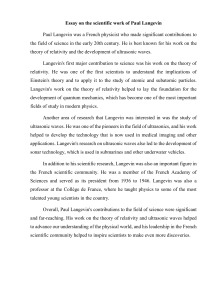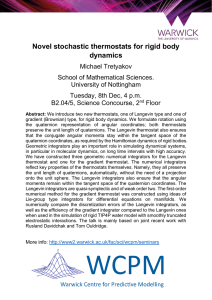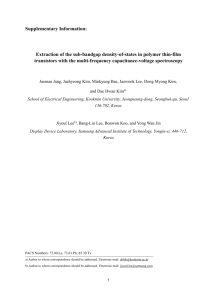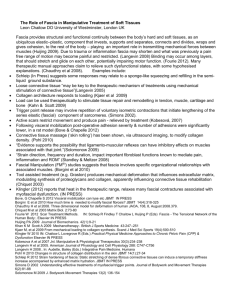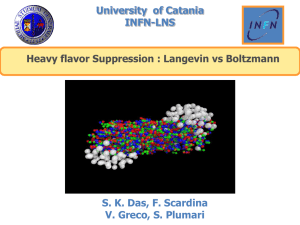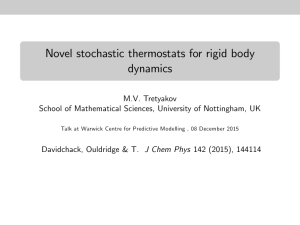IEEE-Sensors-Langevin
advertisement
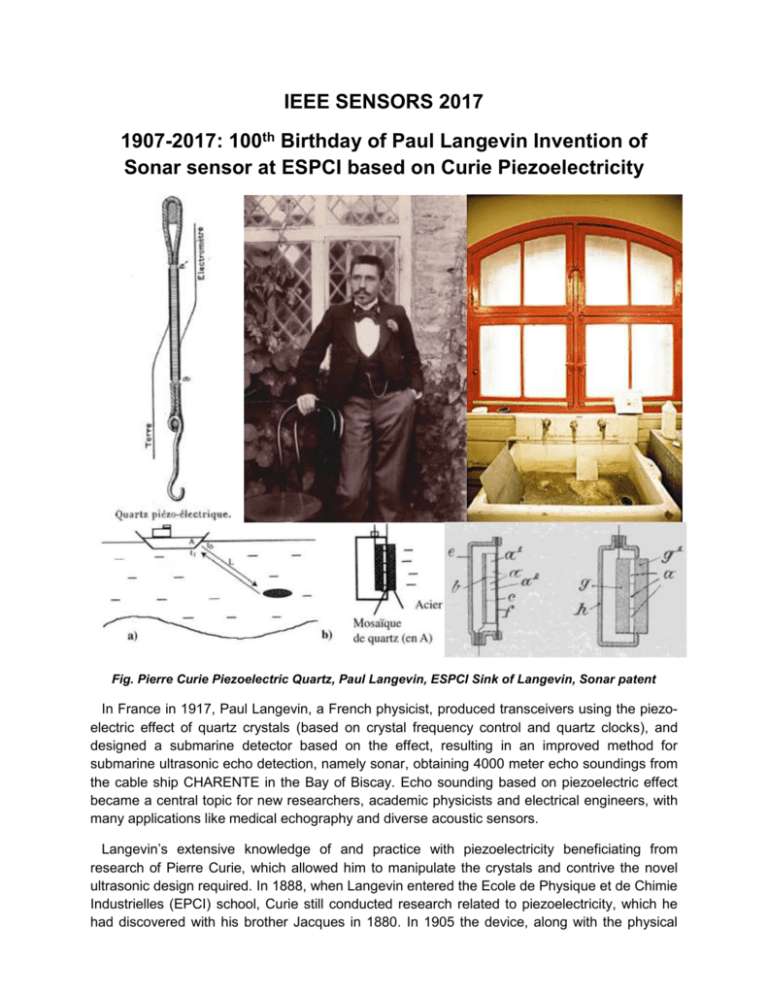
IEEE SENSORS 2017 1907-2017: 100th Birthday of Paul Langevin Invention of Sonar sensor at ESPCI based on Curie Piezoelectricity Fig. Pierre Curie Piezoelectric Quartz, Paul Langevin, ESPCI Sink of Langevin, Sonar patent In France in 1917, Paul Langevin, a French physicist, produced transceivers using the piezoelectric effect of quartz crystals (based on crystal frequency control and quartz clocks), and designed a submarine detector based on the effect, resulting in an improved method for submarine ultrasonic echo detection, namely sonar, obtaining 4000 meter echo soundings from the cable ship CHARENTE in the Bay of Biscay. Echo sounding based on piezoelectric effect became a central topic for new researchers, academic physicists and electrical engineers, with many applications like medical echography and diverse acoustic sensors. Langevin’s extensive knowledge of and practice with piezoelectricity beneficiating from research of Pierre Curie, which allowed him to manipulate the crystals and contrive the novel ultrasonic design required. In 1888, when Langevin entered the Ecole de Physique et de Chimie Industrielles (EPCI) school, Curie still conducted research related to piezoelectricity, which he had discovered with his brother Jacques in 1880. In 1905 the device, along with the physical laboratory, came under the responsibility of Langevin, who succeeded Curie as a physics professor at the school. Back in 1915, he had already considered a piezoelectric ultrasonic sender, although he did not pursue the idea until after he had found problems with his receiver in late 1916. His familiarity with various manifestations of piezoelectricity, especially with different cuts and directions of the effect, allowed him to think flexibly about its uses and to apply it for his needs. Langevin divided his time between Paris and Toulon, where Marcel Tournier, his assistant from EPCI, conducted research in his absence. By early 1917, Langevin had dispensed with the metallic sheet of the original ultrasonic emitter, relying instead on the electrostatic properties of seawater. His new and more efficient ‘mica emitter’ consisted of a metallic plate subjected to alternating current of the desired frequency mounted on a mica condenser used as an insulator and immersed in the water. In the meantime, however, Langevin turned his attention also to the ultrasonic receiver, which until then had seemed to be the simpler part of the system. Yet his in situ experiments showed him that the carbon microphone gave very irregular results, and required delicate regulations in order to keep the sensibility of the carbon contacts approximately constant against the variations in outside pressure due to the movement of the sea. Looking for an alternative, in February 1917 he employed a slim quartz sheet, connected to an electric circuit as a receiver. He employed a crystal of very different dimensions. He used a square instead of a long, thin rectangular sheet, cut in a plane perpendicular to the cut of the crystal in the ‘quartz-balance’. With this cut, he employed the longitudinal effect in quartz, namely the generation of electric voltage along the direction of the changes in pressure (and vice versa), rather than a transverse effect. This design, which allowed a much larger surface to vibrate with changes in water pressure, considerably increased the sensitivity of the plate to ultrasonic waves. In addition, he benefited from French advances in vacuum tube amplification used in radio, which facilitated the detection of the feeble electric signals emitted by the quartz plate. In April, encouraged by the success of the receiver, Langevin modified the device for use also as a transmitter. He employed elastic theory to devise a thicker plate that would be a better piezoelectric transmitter because it resonated at a frequency desired for submarine detection. To this end he used a crystal of exceptional size and purity, obtaining a few sheets of about a square decimeter of surface, and of fifteen millimeters thickness. Later in that year he contrived a steel–quartz mosaic sandwich to obtain the same piezoelectric and elastic properties from easily available crystals. Langevin Patents : [P1] Chilowsky CM, Langevin MP. Procédés et appareils pour la production de signaux sousmarins dirigés et pour la localisation à distance d’obstacles sous-marins. French patent #502913, 1916 [P2] Chilowsky CM, Langevin MP. Production of submarine signals and the location of submarine objects. US Patent #1471547, 1917 [P3] Langevin MP. 1918 ‘Procédé et appareils d’émission et de réception des ondes élastiques sous-marines à l’aide des propriétés piézo-électriques du quartz’ (Brevet francais, No. 505703, 17 Septembre 1918) pp. 538–542 in: Oeuvres Scientifiques de Paul Langevin, CNRS, Paris,1950 References: [1] Shaul Katzir, Who knew piezoelectricity? Rutherford and Langevin on submarine detection and the invention of sonar, Notes and Records, The Royal Society Journal of The History of Science, March 7, 2012 [2] David Zimmerman, Paul Langevin and the Discovery of Active Sonar or Asdic, The Northern Mariner/Le marin du nord, XII, No. 1, pp. 39-52, January 2002 [3] Benoit Lelong, Paul Langevin et la détection sous-marine, 1914-1929: Un Physicien acteur de l’Innovation industrielle et militaire, Epistémologiques, Vol.2, n°1-2, p. 205-232, Juin 2002 [4] Manbachi, A.; Cobbold, R. S. C., Development and application of piezoelectric materials for ultrasound generation and detection. Ultrasound 19 (4): 187., 2011
